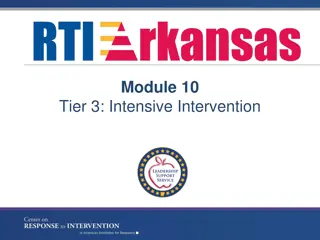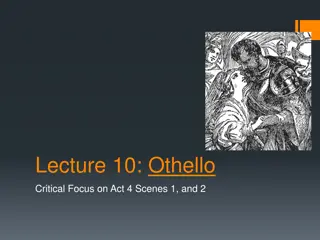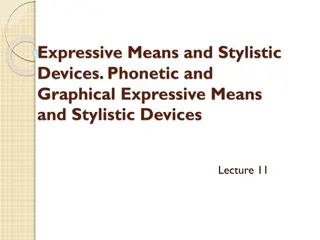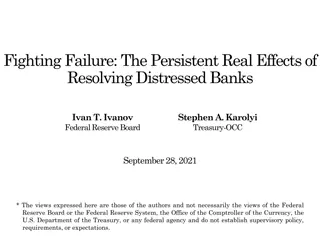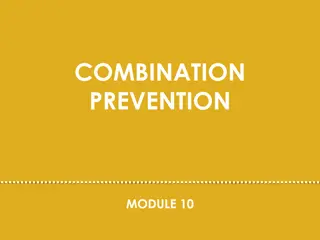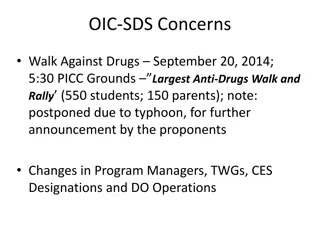
Maximizing Skill Proficiency Through Instructional Design
Explore the instructional hierarchy, cognitive load theory, and forms of practice to enhance skill development in students across proficiency stages. Learn how to optimize learning through evidence-based instruction and design strategies.
Download Presentation

Please find below an Image/Link to download the presentation.
The content on the website is provided AS IS for your information and personal use only. It may not be sold, licensed, or shared on other websites without obtaining consent from the author. If you encounter any issues during the download, it is possible that the publisher has removed the file from their server.
You are allowed to download the files provided on this website for personal or commercial use, subject to the condition that they are used lawfully. All files are the property of their respective owners.
The content on the website is provided AS IS for your information and personal use only. It may not be sold, licensed, or shared on other websites without obtaining consent from the author.
E N D
Presentation Transcript
This presentation contains examples and resource materials that are provided for the user s convenience. The inclusion of any material is not intended to reflect its importance, nor is it intended to endorse any views expressed, or products or services. These materials may contain the views and recommendations of the presenter as well as hypertext links, contact addresses and websites to information created and maintained by other public and private organizations. The opinions expressed in any of these materials do not necessarily reflect the positions or policies of the U.S. Department of Education or Ohio Department of Education and Workforce. The U.S. Department of Education and Ohio Department of Education and Workforce do not control or guarantee the accuracy, relevance, timeliness, or completeness of any outside information included in these materials. Mentions of specific programs or products in these examples are designed to provide clearer understanding and are not meant as endorsements.
Intensifying Interventions: The Power of Practice Managing Cognitive Load Through Instructional Design Jamey Peavler Assistant Professor and Program Facilitator Mount St. Joseph University Graduate Reading Science Program Jamey.Peavler@MSJ.edu
Session Objectives Define proficiency stages (Instructional Hierarchy) How do we know if a skill is truly mastered? Review the Cognitive Load Theory Why do some students experience difficulty making progress despite receiving evidence-based instruction? Outline forms of practice What role does practice serve in developing skill proficiency? Examine recommendations for instructional design How can I maximize learning for my students across Tiers?
How do we know if a skill has reached proficiency? Instructional Hierarchy Haring, et al., 1978 Daly et al., 1996
Instructional Hierarchy (Haring & Eaton, 1978) Proficiency occurs along a continuum of phases. 1. Acquisition 2. Fluency 3. Generalization 4. Adaptation
Instructional Hierarchy Objectives Increase accuracy Provide massed practice to increase repetition Use controlled (blocked) practice to reduce cognitive load Support retrieval through verbal and visual prompts Increase automatic retrieval without compromising accuracy through massed practice Support discrimination of skill among similar skills through interleaved practice Support retention of skill over time (distributed practice) Integrate skill with previously mastered skills Apply the skill across settings without losing accuracy and automaticity Apply the skill in authentic contexts Engage in multistep processes to apply the skill Acquisition Fluency Generalization Adaptation
How can I implement these evidence- based practices? Instructional Design Archer and Hughes, 2011 Hultberg et al., 2018 Jimerson, 2016
Explicit Instruction Explicit instruction breaks up learning into smaller parts. This lightens the cognitive load, or how much brain resources a student needs to process information. A lighter cognitive load frees up working memory. That s important because learning new skills requires a lot of working memory. Understood.org
What do we mean by practice? Each form of practice accomplishes a different purpose More practice isn t as effective as providing the right practice Lesson design should consider how practice fits within a gradual release support structure
Forms of Practice Serve Different Purposes Organization is how the material is presented and affects cognitive load blocked - reduces load interleaved/mixed - increases load Frequency is how often the material is practiced and affects retention massed - quick learning, but also quick forgetting spaced/distributed - slow learning, but long-term retention
Blocked Practice Versus Interleaved/Mixed Practice strainer stern slope calmly cloak brainy trays roaming stream scorned sheath bloat soapy traits ai ay pay say day play stray gray wait paid raid claim drain quaint
Instructional Hierarchy Objectives Increase accuracy Provide massed practice to increase repetition Use controlled (blocked) practice to reduce cognitive load Support retrieval through verbal and visual prompts Increase automatic retrieval without compromising accuracy through massed practice Support discrimination of skill among similar skills through interleaved practice Support retention of skill over time (distributed practice) Integrate skill with previously mastered skills Apply the skill across settings without losing accuracy and automaticity Apply the skill in authentic contexts Engage in multistep processes to apply the skill Acquisition Fluency Generalization Adaptation
Acquisition Stage Explicit Instruction 1. Review Concept Target prerequisite skills (warm-up) and/or most recently taught skills using interleaving 2. Introduce a New Concept - Set the purpose 3. Model demonstrate while narrating the steps 4. Support blocked practice with feedback 5. Review prompted retrieval to check for understanding
Blocked Practice Acquisition Stage sh Visibly groups similar items together Reduces cognitive load Improves accuracy and automaticity But may result in a false sense of security shop shell ship shed sham wish mash fish cash dash
Advanced: Blocked Practice visible vision visual visualize visit visitor revise supervise invisible advise television supervision vis
Instructional Hierarchy Objectives Increase accuracy Provide massed practice to increase repetition Use controlled (blocked) practice to reduce cognitive load Support retrieval through verbal and visual prompts Increase automatic retrieval without compromising accuracy through massed practice Support discrimination of skill among similar skills through interleaved practice Support retention of skill over time (distributed practice) Integrate skills with previously mastered skills Apply the skill across settings without losing accuracy and automaticity Apply the skill in authentic contexts Engage in multistep processes to apply the skill Acquisition Fluency Generalization Adaptation
Interleaved/Mixed Practice Fluency Stage Mixes a variety of items Increases cognitive load through more effortful retrieval Improves skill retention and generalization More accurate performance measure had jog hum rag sit red box rip jet map bus dig
Advanced: Interleaved Practice projector inspection inverting supervisor misaligned contradicted transform restructuring retraction misinformed emerge proactive
When to Move From Blocked to Interleaved? Provide blocked and massed practice until the skill has reached 95% accuracy Then promote the interleaved and massed practice until responses are automatic and less effortful Match this structure for both decoding and encoding
Instructional Hierarchy Objectives Increase accuracy Provide massed practice to increase repetition Use controlled (blocked) practice to reduce cognitive load Support retrieval through verbal and visual prompts Increase automatic retrieval without compromising accuracy through massed practice Support discrimination of skill among similar skills through interleaved practice Support retention of skill over time (distributed practice) Integrate skill with previously mastered skills Apply the skill across settings without losing accuracy and automaticity Apply the skill in authentic contexts Engage in multistep processes to apply the skill Acquisition Fluency Generalization Adaptation
Generalization Stage Controlled Application Once high levels of accuracy and automaticity are reached, provide: distributed practice, incorporating periods of rest between trials to ensure retention opportunities for application in more complex structures Phrase, sentence, or passage-level reading
Interleaved & Distributed Practice Generalization Stage tap the box the big cat mix it up if I can The big cat did jump. Kim is at the shop.
Instructional Hierarchy Objectives Increase accuracy Provide massed practice to increase repetition Use controlled (blocked) practice to reduce cognitive load Support retrieval through verbal and visual prompts Increase automatic retrieval without compromising accuracy through massed practice Support discrimination of skill among similar skills through interleaved practice Support retention of skill over time (distributed practice) Integrate skill with previously mastered skills Apply the skill across settings without losing accuracy and automaticity Apply the skill in authentic contexts Engage in multistep processes to apply the skill Acquisition Fluency Generalization Adaptation
Application Adaptation Stage When a skill has reached the generalization stage, students are ready to apply the skill to read connected text Connected text passages are not the only option for fluency practice Phrases are best for students with difficulty with whole- word reading Sentences are effective when few phonetically irregular words or inflected endings are known
Massed Versus Spaced Massed Practice Repetition occurs within a short time Think of cramming for a test Spaced Practice Repetition is spread over time Periods of rest occur between practice sessions Rest can be created by manipulating timing or by manipulating format (interleaved)
Massed Versus Spaced/Distributed Practice Foy, R. L.,, Sya ban, S.N., Horneffer, P., 2021
Timing: Frequency Provide massed practice until accurate and automatic Then, incorporate periods of rest between sessions If fluency remains high, increase periods of rest Karpicke, J.D. & Roediger, H.L. (2007)
How We Teach Matters How we teach is just as important as what we teach. Archer, 2011 National Center on Intensive Intervention
Active Participation One of the most consistent findings of educational research in recent years is the positive correlation between active student response and academic achievement: Students' acquisition and maintenance of academic subject matter increase as a function of time spent actively engaged in directly related learning tasks. Barbetta et al., 1993, p. 111
Active Participation (Barbetta et al., 1993; Gardner et al., 1994; Greenwood et al., 1984) When we increase opportunities for students to respond, we increase student engagement Responses can be verbal or written Turn and Talk Choral responses Response cards Fill-in-the-blank Interactive Polls
Immediate Feedback In terms of feedback time, the academic performance of immediate feedback was significantly better than that of delayed feedback. The reason may be that, compared with delayed feedback, immediate feedback increases the germane cognitive load while reducing the external cognitive load. (Taxipulati & Hai-Dong Lu, 2021, p. 12)
Immediate Feedback (Opitz et al., 2011) Student outcomes showed statistically significant improvement when receiving immediate versus delayed feedback Most effective forms Visual models and verbal prompts for self-checking Validating and corrective feedback Video or audio feedback (if delayed) (Hattie & Timperley, 2007)
Effective Instructional Design Provides Purposeful Practice Blocked and massed for new content Interleaved and massed practice for reviewing content Spaced practice to ensure retention over time Increased opportunities to respond Reduces Cognitive Load Consistent language and instructional routines Concrete examples with validating and corrective feedback
References Archer, A. & Hughes, C. (2011). Explicit instruction: Effective and Efficient Teaching. New York : Guilford Press. Barbetta, P. M., Heron, T. E., & Heward, W. L. (1993). Effects of active student response during error correction on the acquisition, maintenance, and generalization of sight words by students with developmental diabilities.Journal of Applied Behavior Analysis, 26(1), 111 119. https://doi.org/10.1901/jaba.1993.26-111 Chen, O., Castro-Alonso, J.C., Paas, F., & Sweller, J. (2018). Extending cognitive load theory to Incorporate working memory resource depletion: Evidence from spacing effect. Educational Psychology Review, 30, 483- 501.
Chen, O., Past, F., & Sweller, J. (2021). Spacing and interleaving effects require distinct theoretical bases: a systematic review testing the cognitive load and discriminative-contrast hypotheses.Educational Psychology Review, 33(4), 1499- 1522. https://doi.org/10.1007/s10648-021-09613-w Daly III, E. J., Lentz Jr., F. E., & Boyer, J. (1996). The Instructional Hierarchy: A conceptual model for understanding the effective components of reading interventions.School Psychology Quarterly, 11(4),369. Gardner, R., Heward, W. L., & Grossi, T. A. (1994). Effects of response cards on student participation and academic achievement: A systematic replication with inner-city students during whole-class science instruction. Journal of Applied Behavior Analysis,27(1), 63 71. https://doi.org/10.1901/jaba.1994.27-63
Gillingham, A. & Stillman, B. (1997). Gillingham Manual: Remedial Training for Children with Specific Disability in Reading, Spelling and Penmanship (8th ed.). Cambridge, MA: Educators Publishing Service. Gordon, K. (2020). The advantages of retrieval-based and spaced practice: Implications for word learning in clinical and educational contexts. Language, Speech, and Hearing Services in Schools, 51(4), 955 965. Greenwood, C. R., Delquadri, J. D., & Hall, R. V. (1984). Opportunity to respond and student academic achievement. In W. L. Heward, T. E. Heron, D. S. Hill, & J. Trap- Porter (Eds.), Focus On Behavior Analysis In Education (pp. 58-88). Columbus, OH: Merrill. Hattie, J. & Timperley, H. (2007). The power of feedback. Review of Educational Research, 77(1), 81-112.
Haring, N.G., Lovitt, T.C., Eaton, M.D., & Hansen, C.L. (1978). The Fourth R: Research in the classroom. Columbus, OH: Charles E. Merrill Publishing Co. Heron, T. E., Heward, W. L., Cooke, N. L., & Hill, D. S. (1983). Evaluation of a classwidepeer tutoring system: First graders teach each other sight words. Education & Treatment of Children, 6, 137-152. Hultberg, P., Calonge, D. S., & Lee, E. (2018). Promoting long-lasting learning through instructional design.Journal of the Scholarship of Teaching & Learning, 18(3), 26 43 https://doi.org/10.14434/josotl.v18i3.23179 Jimerson, S. R., Burns, M. K., & VanDerHeyden, A. M. (2016). Handbook of Response to Intervention: The Science and Practice of Multi-Tiered Systems of Support, 2nd Edition. Springer.
Karpicke, J.D. & Roediger, H.L. (2007). Expanding retrieval practice promotes short- term retention, but equally spaced retrieval enhanced long-term retention. Journal of Experimental Psychology, 33(4), 704-719. Krug, D., Davis, T. B., Glover, J. A. (1990). Massed versus distributed repeated reading: A case of forgetting helping recall? Journal of Educational Psychology, 82, 366-371. Opitz, B., Ferdinand, N. K., & Mecklinger, A. (2011). Timing matters: the impact of immediate and delayed feedback on artificial language learning.Frontiers in Human Neuroscience,5, 8. https://doi.org/10.3389/fnhum.2011.00008 Orton, J. L. (1964). A Guide to Teaching Phonics. Cambridge, MA: Educators Publishing Service.
Rome, P. & Osman, J. (1972). The Language Tool Kit. Cambridge, MA: Educators Publishing Service. Sheffield, B. (1991). The Structured Flexibility of Orton-Gillingham. Annals of Dyslexia, 41, 41-53. Sweller, J., (2011). Cognitive Load and Theory. Psychology of Learning and Motivation, 55, 37-76. https://doi.org/10.1016/B978-0-12-387691-1.00002-8 Taxipulati, S., & Lu, H. D. (2021). The Influence of Feedback Content and Feedback Time on Multimedia Learning Achievement of College Students and Its Mechanism.Frontiers in Psychology, 12, 706-821. https://doi.org/10.3389/fpsyg.2021.706821
Figures and Resources Load Types: Rogers, B. (2018), Why Bar-Model Works #2: Reducing Cognitive Load. Reading for Learning. Retrieved 08.24.2023 from: https://readingforlearning.org/2018/03/28/why-bar-model-works-2-reducing- intrinsic-load/ Wimmer, G.E. & Poldrack, R.A. (2017). Retrieved 08.25.2023 from: https://www.biorxiv.org/content/10.1101/158964v1.full Karpicke, J.D. & Roediger, H.L. (2007). Expanding retrieval practice promotes short- term retention, but equally spaced retrieval enhanced long-term retention. Journal of Experimental Psychology, 33(4), 704-719. Cognitive Load Theory for Teachers (2019). Key Stage 2 Math. https://youtu.be/MeIx4FVgPsk?si=ekOf6YYY3FHcDHE9
QUESTIONS? EDUCATION.OHIO.GOV




